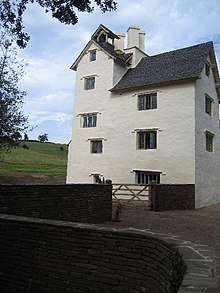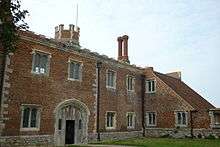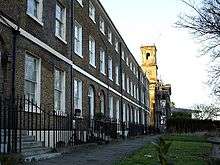Spitalfields Historic Buildings Trust
The Spitalfields Historic Buildings Trust, also known as the Spitalfields Trust, is a British architectural conservation charity. It originated in the Spitalfields area of London, although it also operates elsewhere in England and Wales.[1] The trust's founders include the architectural historians Mark Girouard and Colin Amery and the art historian and television presenter Dan Cruickshank.[2]
The Spitalfields Historic Buildings Trust was founded in 1977 to rescue the remaining Georgian houses in Spitalfields, London, which were threatened with demolition by the expansion of London's financial district. The trust's work was important in the preservation of the network of early 18th-century streets in the area. The trust is largely funded by grants from English Heritage and Cadw, and by loans from the Architectural Heritage Fund.[3][4]
The trust's work has been criticised as leading to the gentrification of Spitalfields, changing a working-class area into "a gentrified enclave for writers, historians and the like", who are "all predominantly white European".[5][6][7]
List of buildings restored by the trust
| Name | Location | Image | Date | Notes | Listed building grade |
|---|---|---|---|---|---|
| Allt-y-Bela | Llangwm Uchaf, Monmouthshire 51.701°N 2.853°W |
 |
Mid-15th century | Built as a hall house in the mid-15th century, originally a single-storey, cruck-frame building with wooden mullions and leaded lights. About a century later a first floor was added with dormer windows and chimneys. A three-storey Renaissance tower was added in 1599.[8] | II*[8] |
| Shurland Hall | Isle of Sheppey, Kent 51.4079°N 0.8655°E |
 |
c. 1532 | A large Tudor gatehouse associated with King Henry VIII[9] | II*[10] |
| The Black House, Gillingham | Gillingham, Kent 51.3837°N 0.5958°E |
Mid-17th century | Farmhouse and worker's cottage,[11] | II[12] | |
| Minor Canon Row | Rochester, Kent 51.3883°N 0.5028°E |
1722–1735 | A terrace of seven houses built between 1722 and 1735 to house the minor canons of the cathedral[13] | I[14] | |
| Varden Street and Turner Street | Whitechapel, London 51.51576°N 0.06055°W |
 |
1809–1815 | Two adjoining terraces of early-nineteenth century houses[15] | |
| Naval officers' quarters | Sheerness Royal Dockyards, Kent 51.4427°N 0.7537°E |
 |
1820s–1830s | Ten houses including Dockyard House, built for the Chief Superintendent of the Royal Dockyard, and five houses forming Regency Terrace. Most were designed by George Ledwell-Taylor.[16] | II* / II[17][18] |
Other buildings with which the trust has been involved
- Malplaquet House, Stepney, London
- Dennis Severs' House, Spitalfields, London
References
- "273695 - Spitalfields Historic Buildings Trust Limited". Charity Commission. Retrieved 22 May 2014.
- "Dan Cruikshank". Random House Speakers. Retrieved 3 December 2014.
- Jenks, Chris (2004). Urban Culture: Critical Concepts in Literary and Cultural Studies. Abingdon, UK: Routledge. p. 205. ISBN 0-415-30497-0.
- Wheater, Caroline (June 2011). "The Spitalfields Trust: One foot in the past". Period Living.
- Mead, Andrew (8 June 2000). "Fount of stories". Architects' Journal. Retrieved 3 December 2014.
- Glendinning, Miles (2013). The Conservation Movement: A History of Architectural Preservation : Antiquity to Modernity. Routledge. p. 353. ISBN 9780415499996.
- Sandercock, Leonie (1998). Towards Cosmopolis: Planning for Multicultural Cities. John Wiley & Sons. p. 170. ISBN 0471971979.
- "Allt-y-bella, Llantrisant Fawr". British Listed Buildings. Retrieved 29 July 2015.
- "From Spitalfields to the Isle of Sheppy". Spitalfields Life. 7 May 2010. Retrieved 22 May 2014.
- Historic England. "The Ruins of Shurland Hall or Castle (1258505)". National Heritage List for England. Retrieved 22 May 2014.
- "A massive crane will be needed to move a 400-year-old house six metres away from the edge of the Lower Rainham Road". kentonline.co.uk. 23 May 2015. Retrieved 18 June 2015.
- "The Black House, Gillingham". britishlistedbuildings.co.uk. Retrieved 18 June 2015.
- "Press Release Re Minor Canon Row" (PDF). Rochester Cathedral. Retrieved 22 May 2014.
- Historic England. "Minor Canons' Row (1139023)". National Heritage List for England. Retrieved 22 May 2014.
- "The Romance of Old Whitechapel". Spitalfields Life. 14 December 2009. Retrieved 22 May 2014.
- "Building Preservation Trust in Dramatic Rescue of Key Endangered Site". Save Britain's Heritage. Retrieved 3 December 2014.
- Historic England. "NUMBERS 1 TO 15 AND ATTACHED RAILINGS, REGENCY CLOSE (1258881)". National Heritage List for England. Retrieved 3 December 2014.
- Historic England. "MEDWAY PORTS AUTHORITY OFFICES (DOCKYARD HOUSE) (1258883)". National Heritage List for England. Retrieved 3 December 2014.